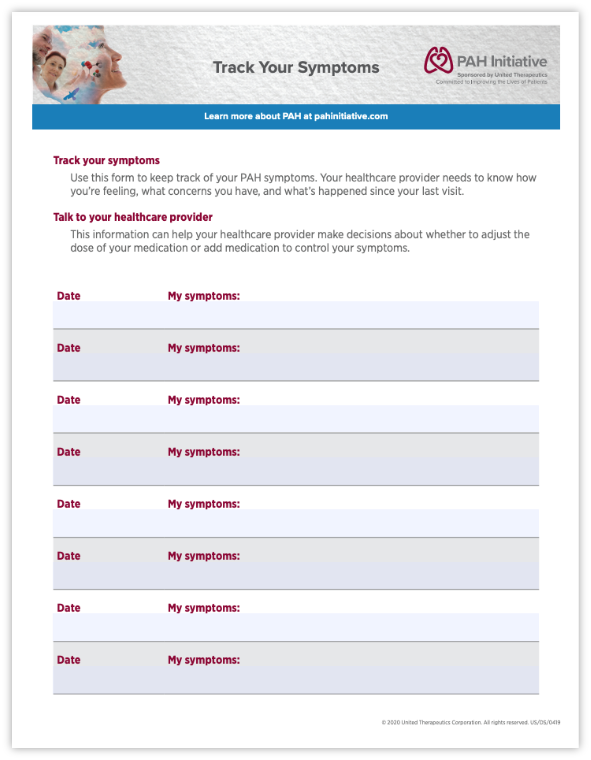What are the symptoms of PAH?
Common symptoms of PAH can include the following:
- Fatigue
- Shortness of breath
- Chest pain
- Dizziness
- Lightheadedness, fainting
- Swollen abdomen
- Swollen ankles
- Irregular heartbeat
Knowing about the symptoms you experience and when you experience them helps your healthcare provider assess whether your condition is improving, staying the same, or getting worse. This is key to determining the right treatment plan. You are likely familiar with at least some of the PAH symptoms like shortness of breath, a rapid, hard, irregular heartbeat, chest pain, swollen ankles, a swollen abdomen, or even dizziness and fainting. Over time, as the disease progresses, the symptoms get worse and you may find that you cannot do as much physically. It’s important to note that symptoms may not always reflect whether PAH is progressing or how it is affecting your body. Even if your symptoms remain the same, there still may be more you can do to help improve how you feel. Sometimes people with PAH try to ignore their symptoms until they become more extreme, but when it comes to PAH, it’s important to speak with your doctor about how you are doing.
Effectively treating PAH sooner rather than later can make a difference in how quickly your PAH progresses. So it’s important to be your own advocate and to find an experienced PAH doctor. Not all pulmonologists and cardiologists have specialized PAH training, so it’s important to find a PAH doctor who understands each of the available PAH medications.
Reducing your PAH symptoms is an important goal
Improving PAH symptoms is a common goal for patients and their healthcare teams. Fortunately, medications can help widen the blood vessels in your lungs. They can also slow down the narrowing of the vessel passages that put strain on your heart as it struggles to keep up.
Taking a closer look at your symptoms
As PAH progresses, you may find that performing routine activities becomes more and more difficult. You may feel worn out, and you may even faint.
It is important to monitor and track your symptoms closely and promptly communicate any changes to your healthcare provider
PAH symptoms may be a sign it’s time to try something else
If you are still having symptoms, your current treatment plan may not be doing enough to control the progression of your disease. If you’ve stopped improving and aren’t where you want to be, talk to your healthcare provider about additional options.
You can learn more about what’s going on in your body that causes PAH symptoms at the link below.
What Is PAH?Keep track of your symptoms in a journal
Your healthcare provider may rely on information about your symptoms to guide your treatment plan. This is why it’s so important to track your symptoms (including what activities you were doing when the symptom[s] occurred) and to tell your healthcare provider if your symptoms aren’t getting better, or are even getting worse. Your healthcare provider can assess your treatment plan and consider whether any changes are needed.
Download the symptom journal to make it easy to monitor your symptoms and discuss them at your next appointment.Discuss your symptoms with a PAH specialist
Not all healthcare providers have experience treating PAH. Healthcare providers with experience treating many PAH patients have specialized training, and know how to evaluate changes to your PAH symptoms and make adjustments to your treatment plan so you can keep improving.
Patients with PAH should see healthcare providers who are specialists in PAH.
Find a PAH SpecialistWhat can you do to improve your symptoms?
You play an active role in your care! When you monitor your symptoms and tell your PAH specialist about any changes, it helps them figure out the best way to treat you. They can also decide if any changes need to be made to your treatment plan. Some changes they might talk to you about could be eating healthier, exercising more, or trying a new medication.
Improving your symptoms may not only help you feel better now so you can continue to do the activities that you enjoy, but it can also help improve your prognosis and the future course of your PAH.
Improving your symptoms could have a positive effect on your future
Improved symptoms could also improve your risk assessment, increasing the chances you’ll be doing better in the future. So, what is risk assessment? It’s a comprehensive assessment that combines your individual test results to give a holistic view of your PAH.

“You need to be honest with your doctor, let them know what you want to do. And you and him, come up with the best plan that you both can handle.”
—Gwen, PAH Initiative AmbassadorWhat types of treatments are available for PAH?
Learn more about the kinds of PAH medications available and how they may help improve PAH symptoms.
Types of PAH Treatments
